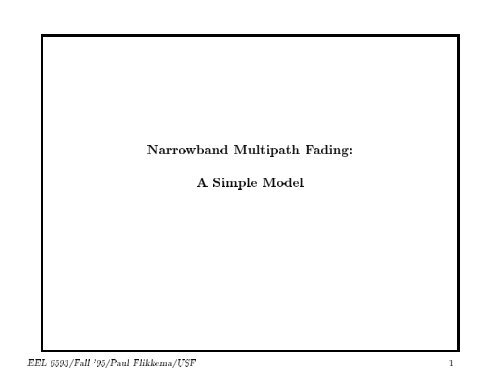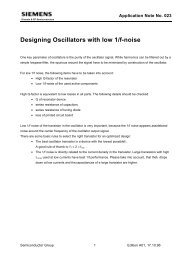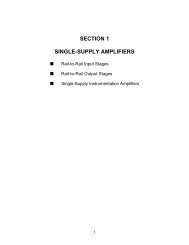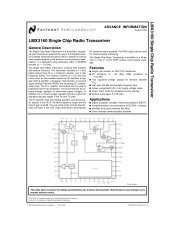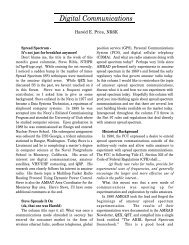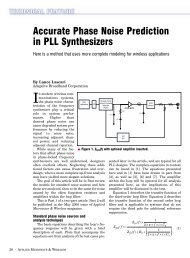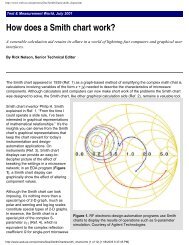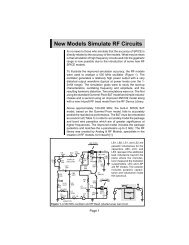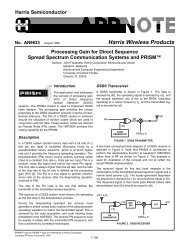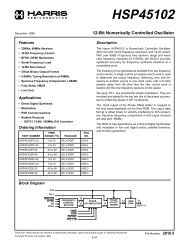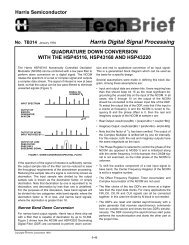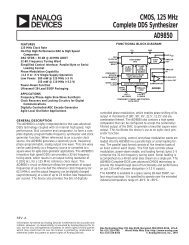Narrowband Multipath Fading: A Simple Model
Narrowband Multipath Fading: A Simple Model
Narrowband Multipath Fading: A Simple Model
- No tags were found...
Create successful ePaper yourself
Turn your PDF publications into a flip-book with our unique Google optimized e-Paper software.
<strong>Narrowband</strong> <strong>Multipath</strong> <strong>Fading</strong>:A <strong>Simple</strong> <strong>Model</strong>EEL 6593/Fall '95/Paul Flikkema/USF 1
Doppler in Wireless ChannelsScenario: mobile at position x, moving with velocity V , with signalarriving at angle :With a nominal carrier frequency of f 0 , the received signal isr(t) =Ae j(2f 0t,x cos )with phase (where = 2 =wavenumber)and resulting Doppler frequency(t) =2f 0 t , V tcos f D = V cos EEL 6593/Fall '95/Paul Flikkema/USF 2
Another way: from physics, for a radial (approaching) velocity V r ,f D = f 01cV r, 1 =f 0V r f 0V rc , V r cBut V r = V cos and c = f 0 sof D = V cos Often, V and will vary with time, so f D will varycorrespondingly, causing Doppler spread. Often this is modeledstatistically. In general, the Doppler spread characterizes the rateof channel variations.EEL 6593/Fall '95/Paul Flikkema/USF 3
Amplitude Variation Due to MotionNow consider the case where two incoming waves arrive at themobile at angles of 0 and . Assume that they are of equalamplitude. Then, from above, the received signal isr(t) =Ae j2f0t (e ,j + e ,j cos )where = x. This can be expressed asr(t) =Ae j2f0t (e ,j(U+D) + e ,j(U,D) )whereU = 1 + cos 2;D = 1,cos 2Factoring, we haver(t)=Ae j2f 0t e ,jU (e jD + e ,jD )EEL 6593/Fall '95/Paul Flikkema/USF 4
Notice that"#e jD + e ,jD (1 , cos )= 2 cos2;so"#r(t) =Ae j2f 0t ,jx(1+cos )=2x(1 , cos )e 2 cos2Thus the phase of signal due to Doppler is(t) = 1 x(1 + cos )2and the Doppler frequency isf D = 12122 V (1 + cos ) = V (1 + cos )2EEL 6593/Fall '95/Paul Flikkema/USF 5
But the signal amplitude uctuates due to multipath according toi.e., with frequency SW (t) = x(1 , cos );2f SW = V 2(1 , cos ):Examples: If = 0 then both waves are arriving from the samedirection, and f SW =0. If = (opposite directions) f SW = V .Interpretation: as mobile moves with constant velocity in a xedmultipath environment, amplitude of the received signal uctuateswith frequency f SW . This is sometimes called the \amplitudestanding wave pattern" due to motion. Notice that as V increases,so does f SW :EEL 6593/Fall '95/Paul Flikkema/USF 6
RemarksThis scenario illustrates two key properties of wireless multipathchannels:1. The fade level (amplitude) varies as a function of position. Inthe general case when a large and random number of pathsexist, the resulting amplitude (envelope) is modeled as arandom variable (e.g., a Rayleigh r.v.).2. The rate of fading uctuations depends on velocity. A roughmeasure of the fading rate is the Doppler spread.Finally, note that channel variations (both level and rate of change)can be caused by objects (i.e., those that reect or absorb thetransmitted energy) other than the transmitter and receiver.EEL 6593/Fall '95/Paul Flikkema/USF 7


